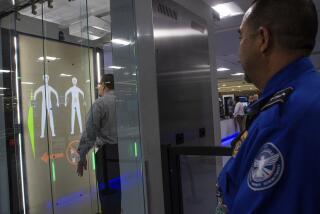Technology Can Be Too Good to Use
- Share via
What if you had to take off your clothes to get on an airplane?
OK, maybe that wouldn’t be all that onerous for flights originating in Los Angeles, where so many people have been surgically altered to present a freakishly perfect facade to the world. But just imagine returning from, say, Delaware. You’d be trying to gouge your eyes out.
Nobody is talking about actually forcing people to disrobe before boarding, but now that we’re in the middle of a war, the Federal Aviation Administration is looking at a number of technologies that can effectively strip people of their clothing, not to mention their dignity. It’s one of many measures being looked at to beef up airport security.
One piece of equipment can show a three-dimensional, computer-generated, fully nude image of a person as he or she passes through the device.
Researchers at the Pacific Northwest National Laboratory, an Energy Department research facility in Richland, Wash., have been working on this holographic imaging system since 1989. The device, called a Personal Security Scanner, doesn’t rely on hard radiation such as X-rays, so it doesn’t have the same health risks. One big reason the system hasn’t been used yet: It’s just too good.
For starters, the device creates a complete image of the human body on a computer screen. The picture leaves nothing to the imagination. It’s all there, warts--or anything else--and all. As a result, the scanner can spot nonmetallic objects concealed under clothing, such as a bag filled with liquid, a ceramic knife or a gun with mostly plastic parts.
The image display lets the people running the system know exactly where on the body the contraband has been concealed, according to Doug McMakin, a staff engineer who has been working on the project since 1989. “The concern on privacy has been raised by the FAA, so that’s what we’ve been trying to resolve,” he said.
Basically, nobody wants security guards pointing at the monitor and cracking up or staring--or whatever--when people pass through.
The FAA and other government agencies have spent more than $12million on the project since 1989. Some of that money went to related uses, such as building a portable system so the military could make sure the wear and tear on a stealth aircraft hasn’t made the plane visible to radar. The lab is awaiting approval of another FAA grant to develop new software. Researchers hope they can rejigger the software so that everything but the naughty bits shows up on the monitor.
“We’ve had some success, but not at the level the FAA deems acceptable at this point,” McMakin said.
The FAA believes that the public simply wouldn’t tolerate such an intrusive measure. Those concerns were explored in a 1996 paper by the National Academy of Sciences Panel on Passenger Screening.
“We concluded that the public would not accept the kinds of costs associated with this system--sacrificing dignity for safety--unless there were some sort of event,” said Kenneth R. Laughery, a psychology professor at Rice University who was a member of the panel. “Now, we had the event Sept. 11. And we’re certainly more willing to consider this sort of thing. But we don’t know how the public will consider those trade-offs over time.”
Laughery points out that with every disaster, the public insists on improved safety. But such demands fade over time as the inconvenience lingers long after the perceived threat fades.
“The other side of that is people adapt,” he said. “The public can accept security procedures, like metal detectors, over the long term. And indeed those kinds of procedures seem much less inconvenient today than they did a month ago. If we were to introduce measures like the holographic system, people may in fact adapt to that.”
That’s exactly what some people are afraid of.
“Unless you conduct full body cavity searches on passengers, someone who wants to get a weapon on board will do it,” said Lauren Weinstein, moderator of Privacy Forum, an online discussion list on privacy issues. “These new technologies will certainly dispose of the concept of privacy, and they will give people the feeling that things are safer. But it’s obvious these see-through gizmos won’t accomplish the stated goal, which is to prevent passengers from seizing or destroying aircraft.”
Weinstein, pointing to several reports on the subject, argued that aircraft security in America has erred in focusing on what people take on board the plane in an attempt to improve safety. “The real issue is the people themselves and how the planes are designed,” he said.
“If Americans are going to be forced to put up with this sort of thing, it had better provide real security,” he said. “This doesn’t.”
More to Read
Inside the business of entertainment
The Wide Shot brings you news, analysis and insights on everything from streaming wars to production — and what it all means for the future.
You may occasionally receive promotional content from the Los Angeles Times.










